
LOW TEMPERATURE PLASMA TECHNOLOGY LABORATORY
Electrical Engineering Department, UCLA
This lab was started in 1989 to try to apply modern plasma techniques to low-temperature plasmas used in commercial applications. The first experiments were to reproduce and understand a highly promising plasma generator, called a helicon discharge, which Prof. Chen had seen in R.W. Boswellís laboratory in Canberra, Australia, in 1985. Having had no previous experience with RF circuits, Chen enlisted the help of Dr. Tatsuo Shoji of Nagoya, Japan, who designed and made our first matching circuit, a double-stub tuner, for frequencies around 30 MHz. The experiments were done with the help of graduate student Chris Decker. Chris later became a laser-fusion theorist and can now be found at the NIF project at Livermore. The first helicon discharge was in a small tube 1 inch in diameter and two feet long. The magnetic field was pulsed with noisy mechanical relays.
After Engineering IV was completed in 1991, we moved into our present quarters. Finding that the laboratory floor was unfinished,. Chen and Decker bought vinyl tiles from a hardware store and laid the floor themselves. Since the 1" tubes were too small to confine electrons at low fields, a new machine was built to accommodate diameters of 2-2Ĺ inches (Fig. 1). A novel square coil mounting system was used, and the coils themselves were simply spools of Formvar-insulated wire direct from the factory. An electronic switching circuit was built to pulse B-field silently. It was in this 2" system that most of the physics of helicon discharges was studied.
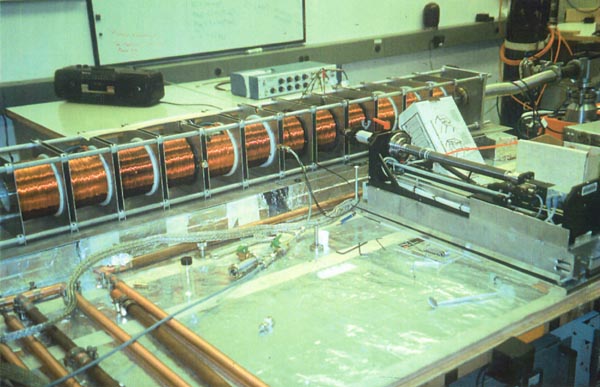
The first 2" helicon source. This was later doubled in length to give a uniform magnetic field over 160 cm.
Most of the initial experiments were done by our first postdoc, Gaetan Chevalier, whose Canadian French accent pervaded the lab. Soon thereafter, graduate students Max Light and Dave Blackwell joined our "permanent" crew. Dave was immediately put to work
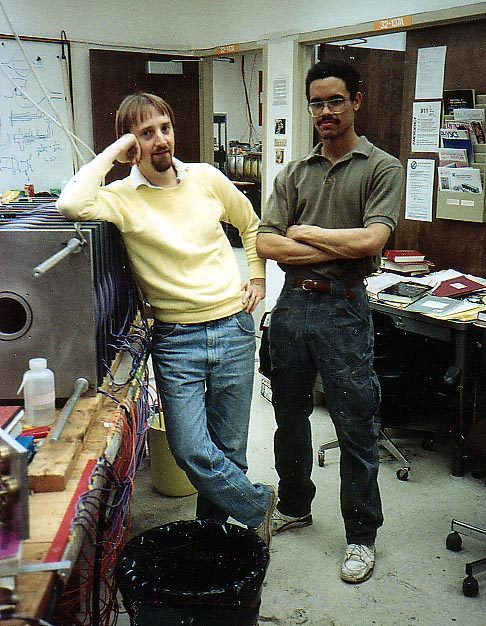
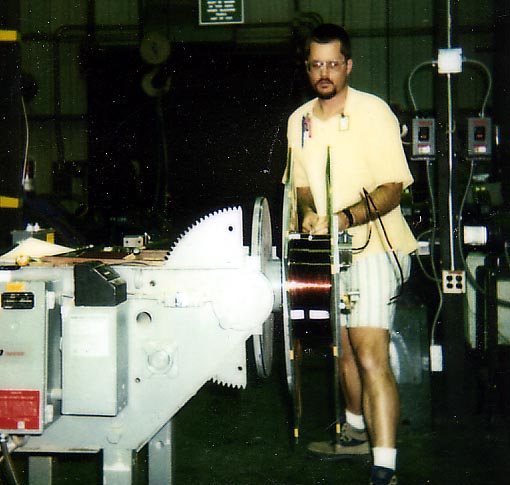
Gaetan and Dave Max winding coils at LANL
constructing our magnet power supplies, while Max made the HexFET switching circuits to replace the chattering relays we had used to pulse the magnetic field. The discharges were always run in long pulses to avoid water cooling of the antenna and to protect the Langmuir probes. Max developed our radial and axial B-dot probes and measured these helicon fields as part of his Masterís work. Soon thereafter, he moved to Los Alamos, where he single-handedly constructed a large helicon-ECR machine for his Ph.D. dissertation. Meanwhile, Blackwell also built a new machine, a large (4-inch) diameter system on which he did both his Masterís and his Ph.D. thesis work. He has developed three new diagnostics for RF discharges: 2D imaging with a CCD camera, an RF time-resolved gridded energy analyzer, and an RF current probe.
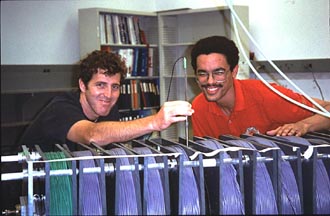
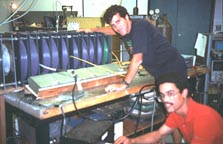
Kiko adjusting a probe on Dave's machine without looking, while Dave looks smugly on.
Activities picked up with the arrival of Isaac ("Kiko") Sudit from Peru and Wisconsin, where he PhD'd on Langmuir probes. A tireless and meticulous worker, Kiko put our work on solid ground by developing a really well compensated Langmuir probe for RF discharges, as well as an optical probe for local light measurements. His careful measurements of plasma parameters in a long helicon discharge and his insightful theoretical analysis greatly advanced our understanding of the equilibrium in these discharges. In this period we also help from temporary students Jonathan Hsieh and Dave Aossey, as well as from several undergraduate summer students. Several senior and postdoctoral researchers have joined the lab for short periods, including Tatsuo Shoji and Motoichi Kawaguchi from Japan, Kostia Shamrai from the Ukraine, Wade Zawalsky from Canada, and Seok-Min Yun from Korea.
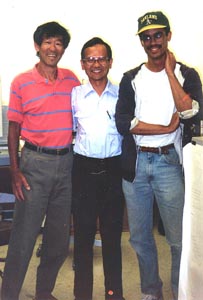
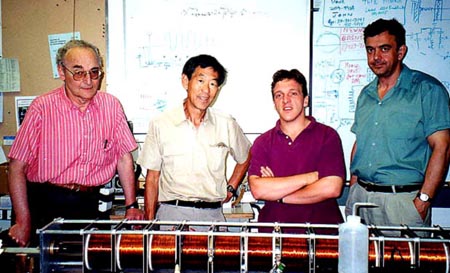
Chen, Kawaguchi, and Blackwell Arnush, Chen, Porte, and Shamrai
After Sudit left, Xicheng Jiang nd Xiao-liang (Shawn) Zhang joined the group. Xicheng carried out a new experiment testing small helicon sources injecting into a magnetic bucket. A tireless worker, he got so much data that the referee told us to leave some out!
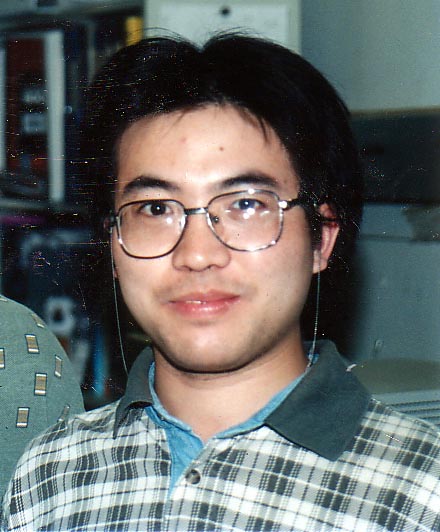
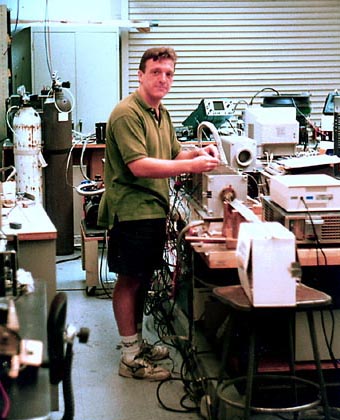
Xicheng Laurie Porte
After that, we were fortunate to have David ("Dave-O") Miljak from Australia for a year. A hot-shot with RF circuits, Dave-O built a double tuning circuits for matching and balancing two antenna at the same time. He performed the first helicon experiment with a rotating RF field, and a double-ended helicon experiment that elucidated the effect of gas depletion in these discharges. Laurie Porte came from England and took over Miljak's apparatus. Between rugby matches, he found an interesting effect with helical antennas. This result was confirmed by "Sam" Yun in his brief stay here.
Picking the helicon discharge as an object of study was both a blessing and a curse. These plasmas are much more complicated than one would have expected, and a surprisingly large number of curious effects have been observed. Fortunately, we have been able to explain most of these puzzles, and in doing so have integrated industrial plasmas with other, more classic, areas of plasma physics. The group was joined by Adj. Prof. Donald Arnush, a theorist who was formerly the scientific director of an isotope separation project at TRW, Inc., a project which involved a helical antenna, and in which the ANTENA code was developed. Working with Frank Chen, he devised a theory and numerical code for treating helicon discharges including the effects of electron mass, collisions, radial density profiles, and antenna coupling. This code has elucidated at least two of the most puzzling features of helicons: the predominance of the right-hand over the left-hand polarized mode, and the unusually high RF coupling efficiency. The antenna coupling was found to be dominated by the excitation of a cyclotron mode (the Trivelpiece-Gould mode) near the surface of the plasma (an effect suggested by Shamrai), rather than by Landau damping, an effect suggest by Chen in 1985. Indeed, careful experiments by Blackwell have shown the absence of Landau damping at densities of order 1013 cm-3.
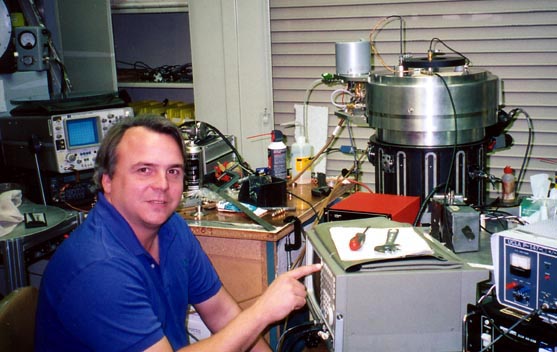
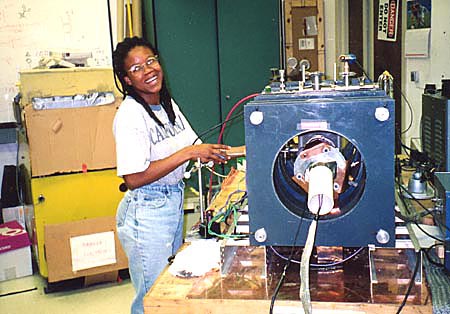
John Tsitsi
From 1995 to 2002, the group was joined by John D. Evans, who had done his Ph.D. on the UCLA tokamak. As laboratory director, John took over daily operations and was also the chief experimentalist. He was mainly responsible for the development of the multi-tube, distributed helicon source, an idea for producing plasmas that can cover very large substrates, including those for flat-panel displays. This work was first done with Dr. George Tynan at PMT, Inc. in Chatsworth, CA. After PMT became Trikon, Inc. and the Chatsworth site was closed, the distributed source work was continued at UCLA, resulting in record densities uniform over 400mm. Evans also extended the single-tube work of Jiang, optimizing the design of antennas and mounts. John has also done a large number of experiments on ICPs (Inductively Coupled Plasmas), sources which do not require a magnetic field and are common in the semiconductor manufacturing industry. The skin depth in ICPs is anomalously large, and Evans and Chen proposed a new explanation of this effect. On Langmuir probes, data taken by Zawalsky and Evans was shown to be inconsistent with existing probe theories, and John proposed a simple, novel method to analyze probe currents to yield correct plasma densities.
Blackwell finished his Ph.D. and has moved to the Naval Research Lab in Washington, D.C. Before that, however, we were fortunate to be joined by a new student, Tsitsi Madziwa of Zimbabwe. Working with Dave, Tsitsi helped develop the RF current probe which was used to show direct evidence of the existence of Trivelpiece-Gould modes. She is now embarking on an experiment to test the physics of the "electron shading" effect in plasma-induced damage in the etching of computer chips. A large part of this problem is the calculation of the ion orbits inside small trenches, a task that is now nearly finished. For a while, our research group had several branches, necessitating weekly conference meetings via phone and the Net. George Tynan, now a professor at UC San Diego, has a new laboratory there and was joined by Yun (who has moved on). Max Light called in from Los Alamos, and Dave Blackwell at NRL was still involved, since he was working on a large-area plasma source there. The group is now down to Arnush, Chen, and Madziwa, but new and exciting results turn up every month, and there is always fodder for discussion and argument.